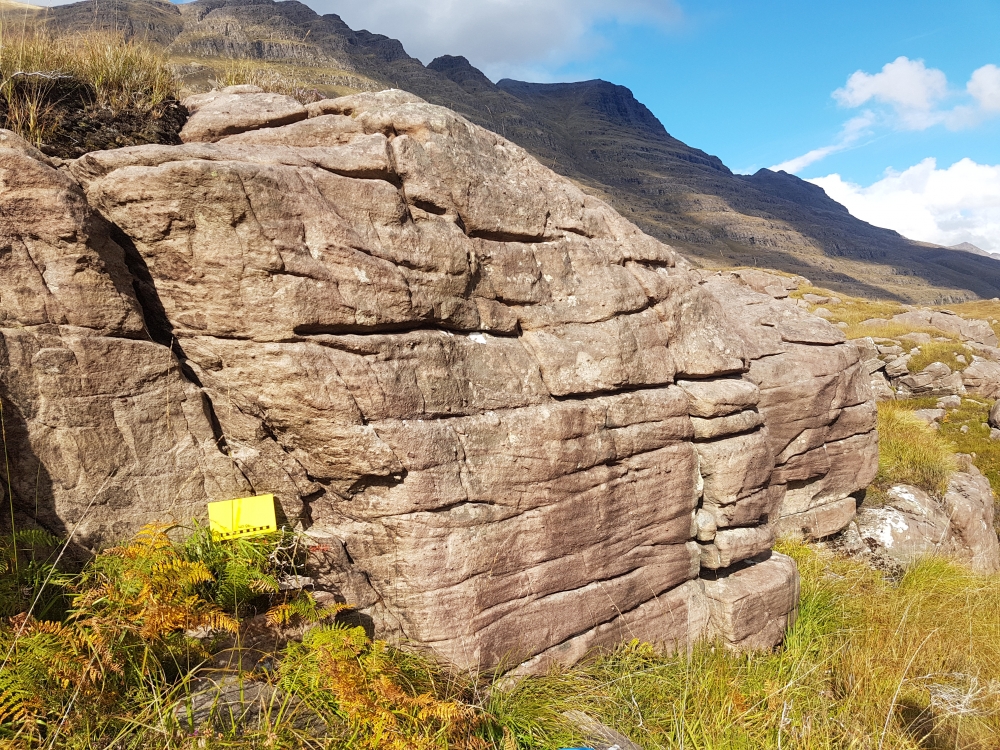
Strangely Ordinary Strata

The Torridon sandstone in northwestern Scotland preserves six kilometers of river sediment from Precambrian times. But what sort of geological events were able to leave their mark for researchers to find 1 billion years later?
Intriguingly, it was not great floods or dramatic course changes — mostly just the regular crawl of sand dunes across the river bottom. In fact, only a few months’ worth.
This ordinariness of river deposits, or fluvial strata, has perplexed geologists for the better part of a century. Given just how little of a river’s history gets preserved, researchers find it odd that records of the commonplace predominate, rather than evidence of the most extreme events. New research published in the journal Geophysical Research Letters, reveals the processes that may finally explain this enigma.
The study led by Vamsi Ganti, an assistant professor of geomorphology at UC Santa Barbara, touches on one of the longest running debates in the field of geology: catastrophism versus uniformitarianism. That is, whether the geologic record tends to be influenced more by large, infrequent events or by small but common occurrences.
When it comes to river deposits, catastrophism has a pretty intuitive argument. “If the probability that any event is preserved is low, then what is preserved should be somehow special,” Ganti explained. However, scientists find this simply isn’t true, even though less than 0.0001% of elapsed time is preserved.
“That’s the reason that we call this the strange ordinariness of fluvial strata,” said Ganti, “because it is strange that preserved events are so ordinary even though the time preservation is so extraordinary.”
River morphology tends to self-organize into a hierarchy of levels, which Ganti and his colleagues believed was the key to understanding this strange ordinariness. Ripples and dunes move across river bottoms on the order of minutes and hours. The movement of sand bars happens over months and years, while rivers meander and jump their banks over years and centuries. At the most extreme end, sea level changes can accelerate erosion or promote sedimentation over the course of millennia.
Fortunately, scientists understand how each of these phenomena appear in the stratigraphic record based on modern observations. It turns out that these features vary in size from inch-high ripples to sea-level induced erosion that can scour hundreds of meters of sediment.
The Otter sandstone preserves river dune migration from the Triassic near Devon, UK.
Photo Credit: VAMSI GANTI
Ganti and his colleagues built a probabilistic model to test their hypothesis. They found that if all river processes happen at the same scales, only the most extreme events get preserved. However, as soon as they introduced a hierarchy, sediment from ordinary processes began filling in the erosion caused by phenomena one level higher.
The mystery was solved. “So long as you have a hierarchical organization in river dynamics, your strata will be ordinary,” Ganti said.
Scientists have known about these different hierarchical levels in river morphology for quite some time, but no one had directly linked them to the ordinariness of river strata until now, Ganti explained. Before these results, sedimentologists were a bit like early biologists who knew about taxonomy — species, genera, families, etc. — without understanding the theory of evolution that explains the dynamics connecting them.
Events in one level can build up sediment — in which case they are preserved — or they can erode away sediment, which will then be filled in by ordinary events one level lower. So, while some extreme events are preserved, common phenomena dominate the stratigraphic record.
Ganti also realized that the relative timeframes over which the levels evolve determine what is preserved. For instance, take the relative rates of river migration versus avulsion, or how often the river jumps its banks. “If your migration is fast and your avulsion infrequent, then you keep reworking your deposits,” Ganti explained. These systems tend to preserve only the most extreme channel elevations. “However, when you have an avulsion, you cannot rework that deposit anymore because you’ve jumped to a new location.”
With this understanding, scientists can now use strata to compare how fast each level was evolving when a river was actually active. In fact, the results bolster the conclusions of Ganti’s previous study, where he had demonstrated that Precambrian rivers could have been similar to the single-channel, meandering rivers we know today.
Scientists had long doubted this since there was no evidence preserved in the stratigraphic record. Many argued that such rivers would have needed plants to secure their banks, and land plants had yet to evolve. But rather than having no migration, in truth it’s likely that these rivers meandered so often that their strata kept getting erased. Indeed, other scientists have found that rivers in un-vegetated landscapes migrate 10 times faster than those with vegetation.
Ganti’s findings also have ramifications for the modern world, where climate change and sea level rise are altering the behavior of major river systems. To understand our future, many scientists look at deposits from rivers during the Paleocene-Eocene Thermal Maximum, when average temperatures abruptly jumped 5 to 8 degrees Celsius, comparable to modern climate change. Evidence suggests that rivers were more mobile then, and now we have the tools to determine why.
“We know that sediment supply to rivers is changing because of human-induced changes. But what we don’t know is what trajectory we are sending rivers on in the long term,” Ganti said.
“Are we going to just increase migration rates? Are we going to make avulsions more frequent? This difference matters, because it determines the flooding history and where you develop in the decades and centuries to come.”




